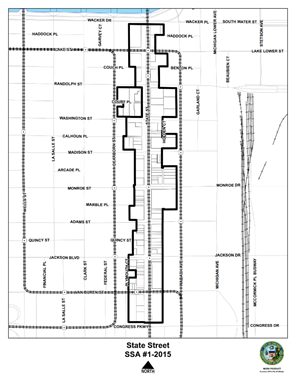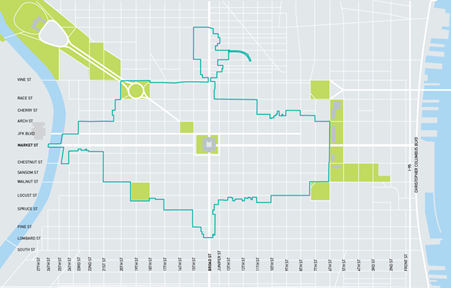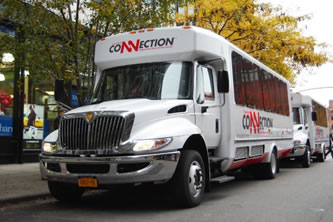Business Improvement Districts (BIDs) are privately directed and publicly sanctioned organizations that supplement public services within geographically defined boundaries by generating multiyear revenue through a compulsory assessment on local property owners and/or businesses. 1 BIDs are managed by public or nonprofit boards, predominantly with local business representation, and often including residents and local governments as well. BIDs create collective economic benefits for their members that cannot be achieved on an individual basis. The BID model is similar to the special assessment value capture technique, as both concepts capitalize on incremental tax assessments levied on properties within a defined geographic area that are directed toward improvement purposes within the district. BIDs often rely on other sources of revenue, in addition to the tax assessment, to fund their operations.

photo credit: Chicago Loop Alliance
BIDs trace their origin back to Toronto, Canada. In the mid-1960s, businesses in the Bloor West Village neighborhood found themselves commercially disadvantaged by the attraction of a new suburban shopping mall. Initially voluntary contributions by an association of local businesses enabled efforts to promote their interests. Disagreement among participants and the prevalence of noncontributing "free-rider" businesses ultimately led to discussions with a number of city representatives and the decision to initiate a business district supported by a self-imposed property tax assessment. This solution required enabling legislation, passed in 1969, forming the Bloor-Jane-Runnymede Improvement Area in 1970. Since that time, the use of BIDs has spread across the globe, especially in the U.S. where their frequent formation in the 1980s and 1990s reflected a desire to combat the decline of city centers, suburban sprawl, and funding and service shortages among local governments.
Common activities of BIDs include providing enhanced security (e.g. uniformed, foot-patrols that coordinate with law enforcement), sanitation (e.g. sidewalk and public space cleaning), and capital improvements (e.g. landscaping and assistance with storefront renovations), as well as leading marketing campaigns to attract consumers, commercial tenants, tourists, and investors. BIDs often develop their own branding and marketing schemes, including logos, slogans, and advertising, as reflected on signage, maps, and publications.

photo credit: Central City District
BIDs are successful when their services match the needs of their constituents. BIDs in dense urban environments with multiple members and relatively high property values typically operate with multimillion dollar budgets and offer a full complement of services. They may also have the legal capacity to bond against their revenues for capital projects. BIDs help augment and improve services generally provided by the municipality and increase the efficiency and quality of outcomes of those typically legally required of businesses, such as sidewalk cleaning.
BIDs are created at the municipal level under authority granted through state-level enabling legislation. Laws that enable BIDs vary from state to state, but most BIDs require approval by a majority of relevant stakeholders. Typically, BIDs are subject to sunset clauses that require their renewal every few years. However, BIDs rarely dissolve, as enabling legislation often incorporates a standard reauthorization process for their renewal and extension.
The major limitation on the use of BIDs is that they must fund improvements that provide local benefits within the district. They cannot be used to fund improvements that benefit the larger community. Therefore, BID funding for transportation typically has been limited to landscaping, sidewalk maintenance and cleaning, and BID-provided local transportation service or support for transit service within the BID. Some BIDs also act as a transportation management associations (TMAs), which "provide transportation services and education to businesses and employees in a particular area, combining the efforts of many employers to reduce program costs. Most TMAs are non-profit collaborations of private and public sector employers working together toward common goals, such as congestion mitigation or pollution reduction." 2

photo credit: Central City District
Started in 1991, Central City District represents 233 blocks and 1,500 properties, providing security, cleaning and promotional services. CCD also makes physical improvements, including the installation and maintenance of lighting, signs, banners, trees and landscape elements.
Two examples of BIDs acting as TMAs include the Pittsburgh Downtown Partnership and the Tampa Downtown Partnership. Typically, TMAs focus on non-motorized initiatives to reduce congestion, improve wayfinding, assess mobility and safety issues, improve parking options, and encourage transit usage.

photo credit: Downtown Alliance
New York City has 75 BIDs, the largest BID program in the country. In FY 2017, they collectively invested over $147 million into local economies. Six have annual budgets greater than $5 million. The Grand Central Partnership was the first BID in the U.S. to finance streetscape improvements. The Downtown Alliance provides free shuttle bus service within its boundaries between the South Street Seaport and Battery Park City in Lower Manhattan, serving roughly 900,000 workers, residents, and tourists annually.
1. Hoyt, L. and D. Gopal-Agge. 2007. "The Business Improvement District Model: A Balanced Review of Contemporary Debates." Geography Compass, Vol. 1, No. 4, pp. 946-958.
2. Texas A&M Transportation Institute. Undated. "Transportation Management Associations." https://mobility.tamu.edu/mip/strategies-pdfs/travel-options/executive-summary/transportation-management-associations-1-pg.pdf (As of October 23, 2018).